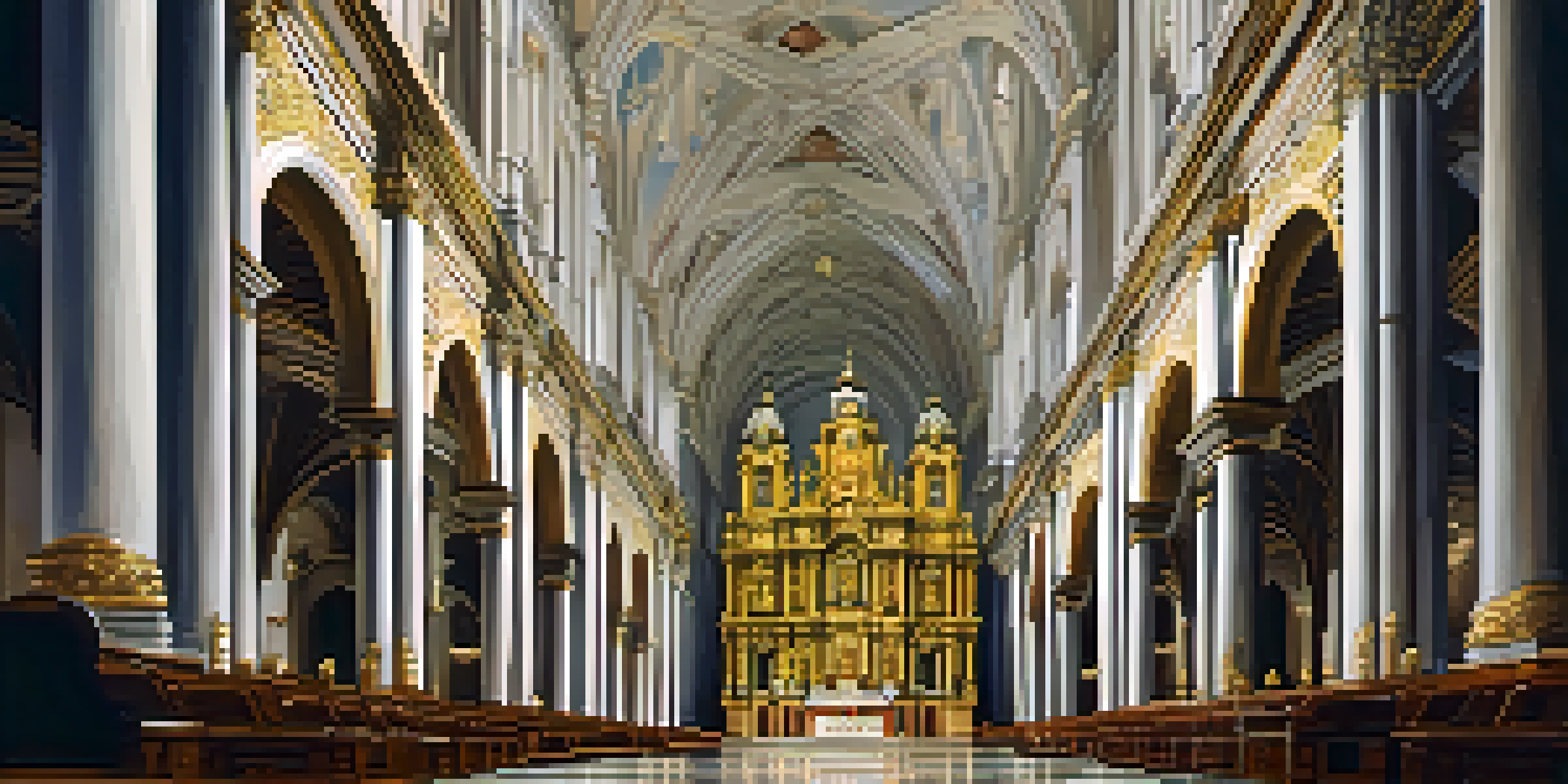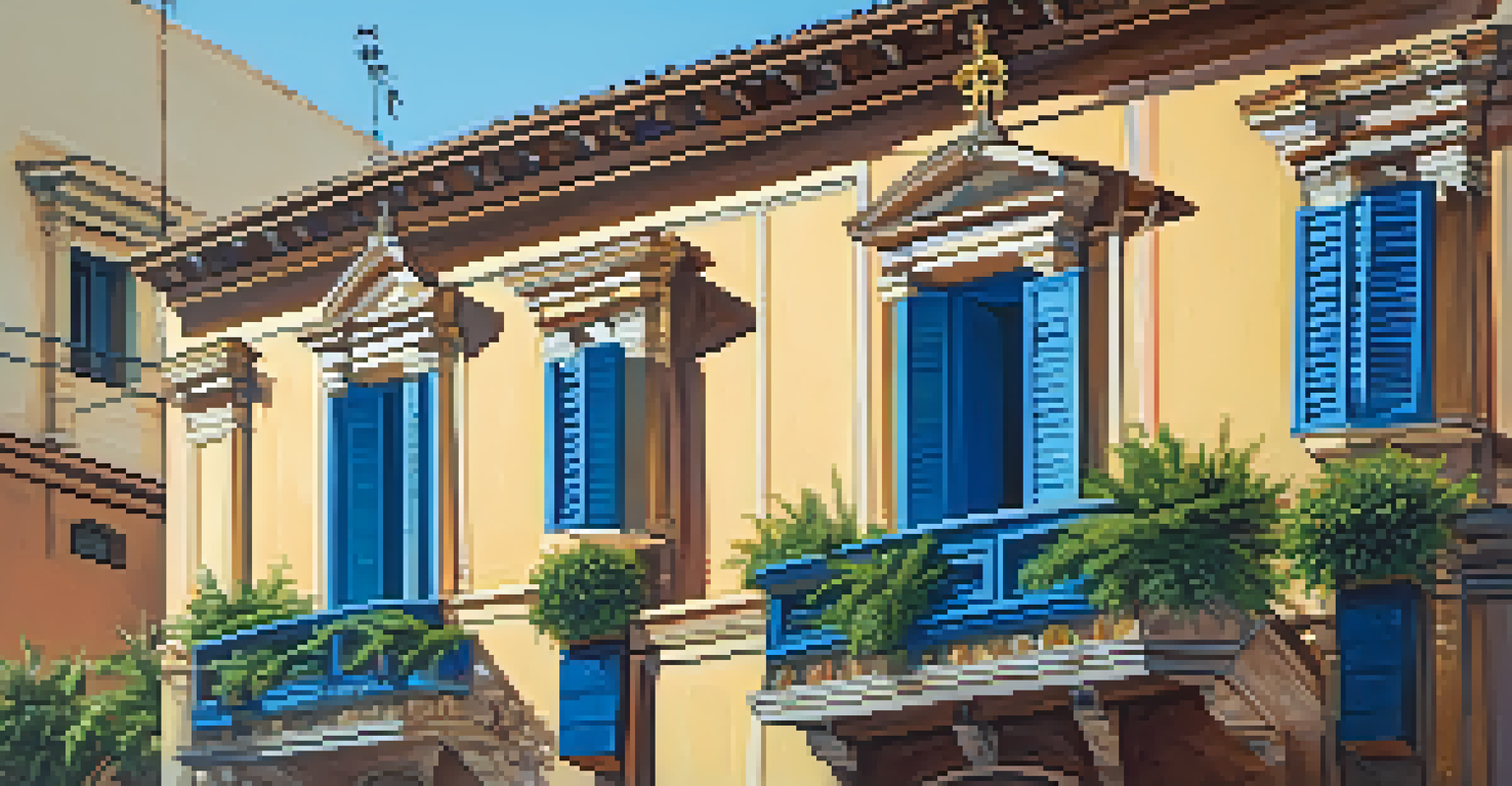Baroque Influence: Peru's Rich Artistic Architectural Heritage

Understanding Baroque: A Glimpse into Its Origins
The Baroque period emerged in the late 16th century, characterized by its dramatic style and elaborate details. Originating in Italy, this artistic movement spread across Europe, leaving a profound impact on various mediums, including architecture, painting, and sculpture. In Peru, Baroque style found a unique expression, blending European influences with indigenous techniques and materials.
Art is the most beautiful of all lies.
This fusion created a vibrant aesthetic that resonated with Peru's rich cultural heritage. The Baroque style was not just about decoration; it conveyed religious themes and societal values, making art accessible to the masses. As a result, Peru became a melting pot of artistic innovation during the colonial period.
Understanding the roots of Baroque helps us appreciate its profound influence in Peru, setting the stage for the country's rich artistic landscape. As we delve into Peru's architectural treasures, we can see how this style evolved and adapted to local contexts.
Key Characteristics of Baroque Architecture in Peru
Peruvian Baroque architecture is marked by its ornate facades, intricate carvings, and grandiose structures. This style often includes elements like curved lines, dramatic lighting, and a sense of movement, which create a dynamic visual experience. Churches and cathedrals, in particular, showcase this elaborate design, drawing the eye and inviting exploration.

A notable feature of this architecture is the use of local materials, such as adobe and stone, which blended seamlessly with European techniques. This not only gave buildings a distinct look but also made them more resilient to the region's environmental challenges. The fusion of styles can be seen in the iconic churches of Cusco, where Baroque elements coexist with indigenous motifs.
Baroque's Roots in Peru
The Baroque style in Peru emerged as a unique blend of European influences and indigenous techniques, enriching the country's cultural heritage.
The beauty of Baroque architecture in Peru lies in its ability to tell stories through its design. Each building stands as a testament to the cultural exchange between Europe and the Americas, inviting visitors to appreciate the craftsmanship and history embedded in every detail.
Notable Baroque Structures in Peru
One of the most celebrated examples of Baroque architecture in Peru is the Cathedral of Lima. Completed in the 18th century, its stunning facade and ornate interiors reflect the grandeur of the Baroque style. The intricate altarpieces and lavish decorations showcase the artistry of the period, making it a must-visit landmark.
Architecture is the learned game, correct and magnificent, of forms assembled in the light.
Another remarkable structure is the Church of San Francisco in Lima, known for its stunning Baroque details and unique wooden balconies. This church not only serves as a religious site but also as a cultural hub, offering insight into the Baroque legacy in Peru. Visitors can marvel at the impressive collection of colonial art housed within its walls.
Additionally, the Cathedral of Cusco stands out with its blend of Baroque and indigenous architectural elements. This fusion highlights the historical significance of Cusco as the former capital of the Inca Empire, making it a focal point for understanding Peru's artistic evolution.
The Influence of Religion on Baroque Art
Religion played a pivotal role in shaping Baroque art and architecture, serving as both inspiration and patronage. In Peru, the Catholic Church was a significant force, commissioning grand churches and artworks to communicate religious narratives. This emphasis on faith resulted in buildings designed to inspire awe and devotion among worshippers.
The intricate altarpieces and religious sculptures found in Baroque churches often depict biblical stories, serving as visual sermons for the faithful. Artists used their skills to create a sense of drama and emotion, inviting congregants to reflect on their spirituality. The use of symbolism and elaborate ornamentation further enhanced the storytelling aspect of these works.
Religious Themes in Baroque Art
In Peru, Baroque art and architecture were heavily shaped by religious motivations, with churches designed to inspire awe and reflect spiritual narratives.
This religious influence is evident in Peru's Baroque architecture, where each church serves as a canvas for expressing faith through art. The powerful combination of architecture and religious themes continues to resonate with visitors, providing a glimpse into the spiritual life of colonial Peru.
Indigenous Influence on Baroque Style
While Baroque architecture in Peru was heavily influenced by European styles, indigenous elements played a crucial role in shaping its unique character. Local artisans incorporated traditional designs, materials, and construction techniques, resulting in a style that was distinctly Peruvian. This blend of influences created a rich tapestry of artistic expression that reflects the country's diverse cultural heritage.
For example, indigenous motifs often appear in the carvings and decorations of Baroque churches, serving as a reminder of Peru's pre-Columbian past. These elements not only add aesthetic value but also symbolize the resilience of indigenous culture amid colonial influences. This cultural integration is a testament to the adaptability of art in response to changing societal dynamics.
The indigenous influence on Baroque architecture is an essential aspect of Peru's artistic identity. It showcases how the past and present can coexist, creating a narrative that honors both indigenous traditions and colonial legacies.
The Legacy of Baroque Art in Contemporary Peru
The influence of Baroque art and architecture remains evident in contemporary Peru, where historical structures continue to inspire modern artists and architects. Many of today's creations draw upon the intricate details and emotional depth characteristic of the Baroque style. This connection to the past fosters a sense of cultural pride and identity among Peruvians.
Additionally, the preservation of Baroque buildings is crucial for maintaining Peru's architectural heritage. Efforts to restore and protect these sites highlight the importance of cultural conservation, ensuring that future generations can appreciate their historical significance. This commitment to preservation also supports tourism, attracting visitors eager to experience Peru's rich artistic legacy.
Cultural Festivals Celebrate Baroque
Festivals in Peru, such as the Feast of Corpus Christi, showcase the enduring influence of Baroque art, fostering community pride and cultural engagement.
As we navigate the complexities of modern society, the Baroque influence serves as a reminder of the power of art to transcend time. It encourages us to celebrate our cultural roots while embracing contemporary expressions of creativity, forging a bridge between the past and the present.
Exploring Baroque Art Through Festivals and Events
Festivals and cultural events in Peru offer a vibrant platform to celebrate Baroque art and architecture. These occasions often feature traditional music, dance, and art exhibitions, showcasing the enduring influence of the Baroque style in contemporary culture. Such celebrations not only honor artistic heritage but also foster community engagement and pride.
For instance, the Feast of Corpus Christi in Cusco highlights the intricate processions and floral decorations that reflect Baroque aesthetics. Participants dress in traditional attire, carrying beautifully adorned altars, creating a visual spectacle that draws locals and tourists alike. This event serves as a living testament to the cultural significance of Baroque art in Peru's social fabric.

By participating in these festivals, visitors gain a deeper appreciation for the artistic traditions that shape Peru's identity. It’s an opportunity to witness how Baroque art continues to thrive and evolve, connecting people through shared cultural experiences.